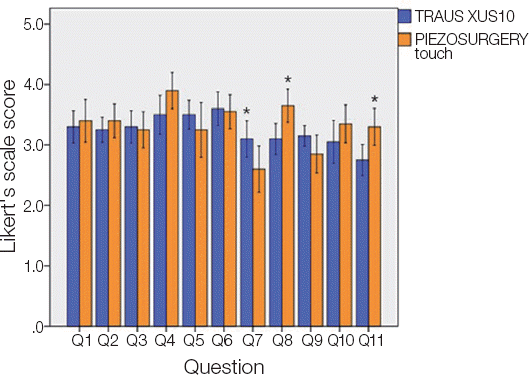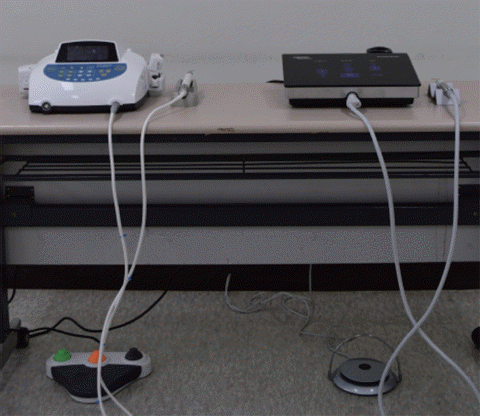Introduction
Materials and Methods
1. User’s satisfaction survey
Table 1
2. Evaluation of the noise from the handpiece
3. Evaluation of the heat emissions of the handpiece
4. Statistical analysis
Table 3
| Question | n (%) | Mean (SD) | ||||
|---|---|---|---|---|---|---|
| Very dissatisfied | Dissatisfied | Average | Satisfied | Very Satisfied | ||
| 1* | 0 (0) | 1 (5) | 12 (60) | 7 (35) | 0 (0) | 3.3 (0.6) |
| 2* | 0 (0) | 0 (0) | 15 (75) | 5 (25) | 0 (0) | 3.3 (0.4) |
| 3* | 0 (0) | 0 (0) | 15 (75) | 4 (20) | 1 (5) | 3.3 (0.6) |
| 4* | 0 (0) | 1 (5) | 9 (45) | 9 (45) | 1 (5) | 3.5 (0.7) |
| 5* | 0 (0) | 0 (0) | 10 (50) | 10 (50) | 0 (0) | 3.5 (0.5) |
| 6* | 0 (0) | 1 (5) | 6 (30) | 13 (65) | 0 (0) | 3.6 (0.6) |
| 7* | 0 (0) | 3 (15) | 12 (60) | 5 (25) | 0 (0) | 3.1 (0.6) |
| 8* | 0 (0) | 2 (10) | 14 (70) | 4 (20) | 0 (0) | 3.1 (0.6) |
| 9* | 0 (0) | 0 (0) | 17 (85) | 3 (15) | 0 (0) | 3.2 (0.4) |
| 10* | 1 (5) | 1 (5) | 15 (75) | 2 (10) | 1 (5) | 3.1 (0.8) |
| 11* | 0 (0) | 6 (30) | 13 (65) | 1 (5) | 0 (0) | 2.8 (0.6) |
* 1, ease of attachment and detachment of Tip; 2, weight and balance of the ultrasonic handpiece; 3, appropriateness of the form and shape (design) of the handpiece; 4, cutting ability of hard tissue and adequate bone cutting properties; 5, wide strength band; 6, wide irrigation area; 7, noise level of irrigation pump motor; 8, satisfaction with regards to function keys; 9, level of noise; 10, amount of vibration; 11, heat emission from handpiece
Table 4
| Question | n (%) | Mean (SD) | ||||
|---|---|---|---|---|---|---|
| Very dissatisfied | Dissatisfied | Average | Satisfied | Very Satisfied | ||
| 1* | 3 (15) | 6 (30) | 11 (55) | 3.4 (0.8) | ||
| 2* | 1 (5) | 10 (50) | 9 (45) | 3.4 (0.6) | ||
| 3* | 2 (10) | 11 (55) | 7 (35) | 3.3 (0.6) | ||
| 4* | 5 (25) | 12 (60) | 3 (15) | 3.9 (0.6) | ||
| 5* | 1 (5) | 2 (10) | 10 (50) | 5 (25) | 2 (10) | 3.3 (1.0) |
| 6* | 1 (5) | 7 (35) | 12 (60) | 3.6 (0.6) | ||
| 7* | 1 (5) | 9 (45) | 7 (35) | 3 (15) | 2.6 (0.8) | |
| 8* | 1 (5) | 5 (25) | 14 (70) | 3.7 (0.6) | ||
| 9* | 6 (30) | 11 (55) | 3 (15) | 2.9 (0.7) | ||
| 10* | 1 (5) | 12 (60) | 6 (30) | 1 (5) | 3.4 (0.7) | |
| 11* | 1 (5) | 13 (65) | 5 (25) | 1 (5) | 3.3 (0.7) | |
* 1, ease of attachment and detachment of Tip; 2, weight and balance of the ultrasonic handpiece; 3, appropriateness of the form and shape (design) of the handpiece; 4, cutting ability of hard tissue and adequate bone cutting properties; 5, wide strength band; 6, wide irrigation area; 7, noise level of irrigation pump motor; 8, satisfaction with regards to function keys; 9, level of noise; 10, amount of vibration; 11, heat emission from handpiece
Results
1. User’s satisfaction survey
 | Fig. 3Comparison for each survey question. * Statistically significant with P < 0.05. Q1: ease of attachment and detachment of Tip, Q2: weight and balance of the ultrasonic handpiece, Q3: appropriateness of the form and shape (design) of the handpiece, Q4: cutting ability of hard tissue and adequate bone cutting properties, Q5: wide strength band, Q6: wide irrigation area, Q7: noise level of irrigation pump motor, Q8: satisfaction with regards to function keys, Q9: level of noise, Q10: amount of vibration, Q11: heat emission from handpiece. |




 PDF
PDF Citation
Citation Print
Print






 XML Download
XML Download